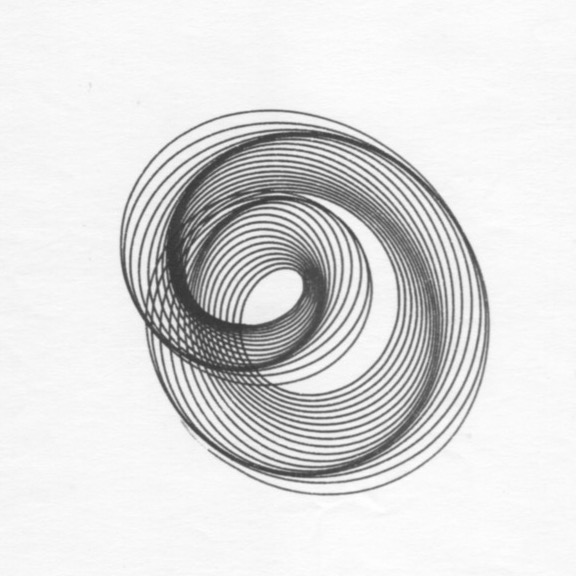FAQ
Q: it sounds as if you do not have control over the drawing initially
— only when you judge it good, and raise the pen?
A: Yes.
A: Working on more for this one. May re-arrange the questions, in order to tell the story better.
Q: Did you know what type of design you would be making? How could you make
a elliptical (roundish) design or flame/tulip (pointy) design?
A: After much experimentation and calibration of the lower pendulum, I developed an intuitive notion of how to make certain patterns.
A: As described on the main page, one could get the whole thing moving in some circular motion with the lower pendulum hanging lifeless. The deftly (and carefully!) reach the lower pendulum and give it a yank or other wise deflect it. Then, if the combined motion seemed interesting, lower the pen.
A: There was also the setting of the position of movable weights on the lower pendulum. Moving them up shortened the effective length and increased its frequency noticeably, creating more frenetic diagrams. Lowering the weights created more mellow diagrams.
A: note on setting up counter motions of upper & lower pendulums
Q: If you hadn't raised the pen would it continue to draw until the pattern was dense and black?
A: Yes, black in the middle. The pendulums lose energy over time, so the successive cycles or loops are 'smaller'.
And, since the lower pendulum quiets down before more massive upper one, the pattern decays into a roundish or oblong spiral. It would essentially spiral in to the center point where the pen tip would be when the pendulum is at rest.
A: Worst thing that could happen was to run out of ink in the middle of a cool pattern. So, the ink dropper was always at hand.
Q: Would the oscillation(s?) gradually decay and stop, or would they continue forever?
A: They gradually decay, due to friction in the bearings, and to a lesser degree, air.
A: Mechanical harmonographs can have gears and motors, such has those that drew on engraving plates for paper money, and can draw indefinitely.
Q: Does Foucault's pendulum go forever without external push?
A: Good Question. Foucault's pendulum (FP) will also decay to Rest. FP has a massive round, smooth weight, and a long fine wire for its length all to minimize air friction. I think some of the FP-like devices cheat — they have an electro magnet at the zero point that pulses just after the orb goes by, replacing the energy lost due to friction. For this to work, the Orb must contain some ferro-magnetic material.
Q: How about a double nib/double color pen?
A: No thanks. See the MoMath Moscovitz gallery for examples of that. BTW, you can definitely draw a second harmongram over the top of an earlier one -- at the risk of spoiling it. LOL
NOTE to SELF: refactor main page and FAQ - duplication may annoy some folks.
NOTE to READER: We didn't have YouTube tutorials or simple videos to watch before even trying it!
